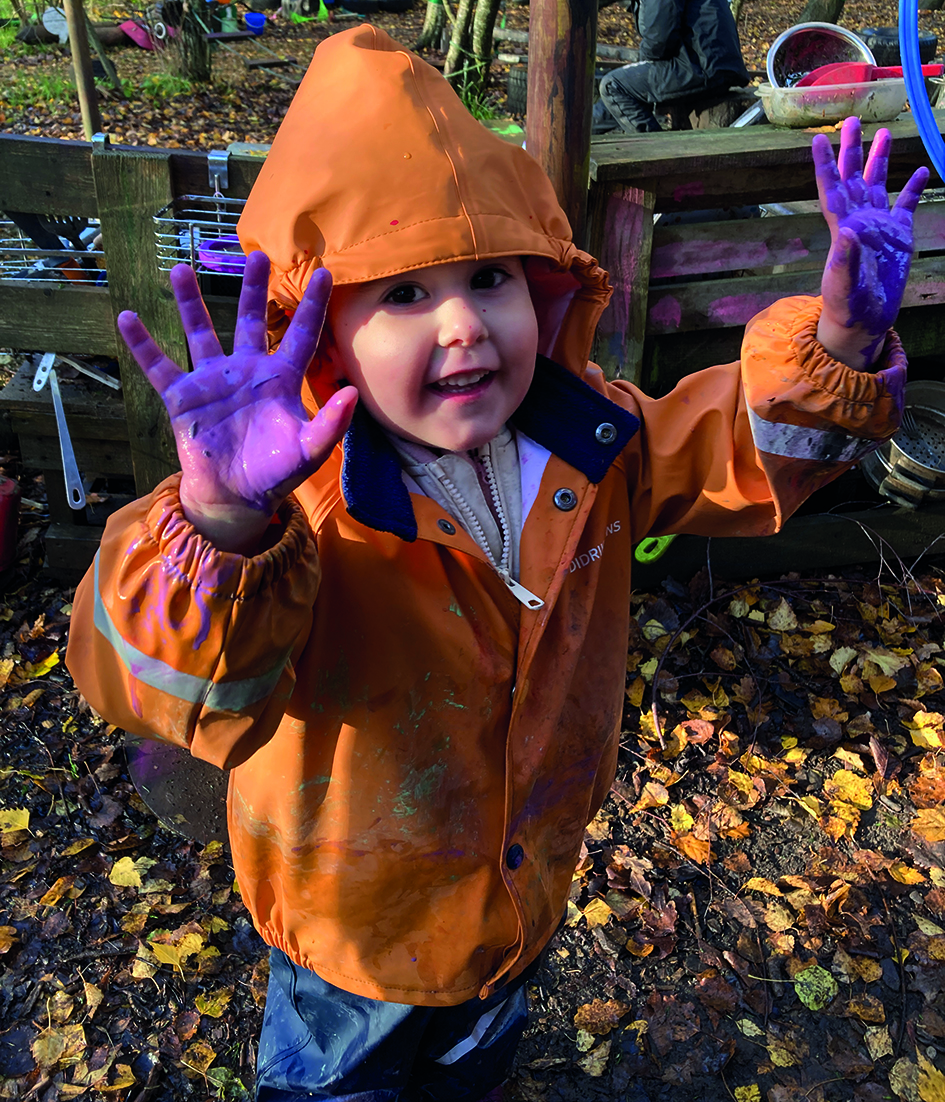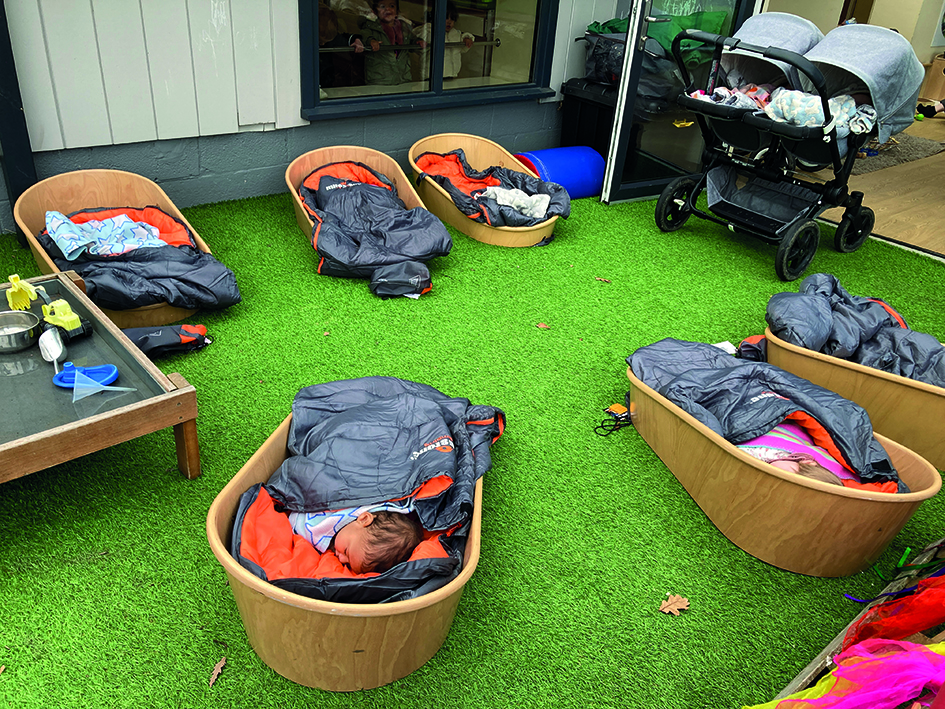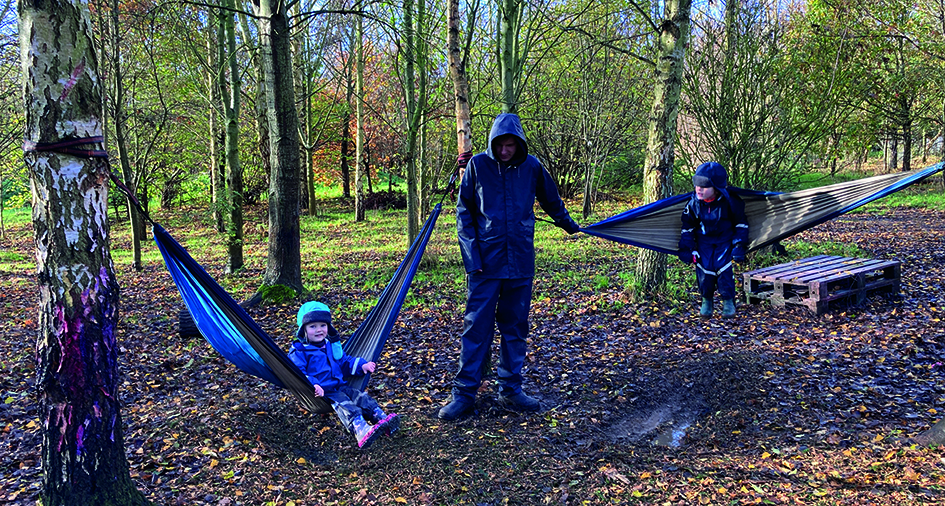
In all of these enabling environments I’ve visited for this series, the appearance was of far less importance than their offer. With my professional background in landscape architecture, I’ve long railed against the dull, ugly, poor-quality, characterless playgrounds that transmit clear messages to children about how we as a society value their needs and rights. But an attractive and compelling space for children isn’t supposed to be like a show garden, it should be a place of irresistible temptations – to touch, feel, smell, climb, test, grab, hide in, jump over, collect and create.
If you are a small nursery with a limited outdoor area, take advice from Kids Planet Stretton. ‘Look at what excites the children; have as much nature as possible – even if your outdoor area is fairly small like ours, a few pots with plants and herbs can make a huge difference.’


From left: Beetle Woods, and Ashbridge
The nature of the building at this setting – a Victorian house set back from a busy road – means children can’t have direct access to outdoors, so instead staff plan regular and frequent time outdoors. Children enjoy traditional pre-school fixed outdoor features, but staff are well resourced to plan in the moment, using easily accessed and stored resources. ‘We’re always looking at how we can improve the garden, using observations of how children are using it, what they’re enjoying,’ said Heather Kennedy, Stretton’s outdoor lead. ‘Some of the features we have now will probably go over the next few years so we can focus more on larger loose parts that give children the ability to change the space each time they use it.’
Another setting which doesn’t let a lack of direct access to outdoor space prevent them from doing Forest School is Holmsdale Manor, where children regularly walk a mile each way through fields and on footpaths to reach the woodland. Every space on the main site fosters curiosity and challenge, and as 2018 trainer of the year Katie Ward explained, ‘We’re definitely lucky to have such a huge garden, but we’ve also been able to retain a very highly qualified staff team, and they make sure each part of it provides stimulus for children no matter what their age, stage or ability. Passionate members of staff with an interest in developing outdoor provision are the most important – without them, it’s difficult to do.’
Time outdoors should not be restricted; at Ashbridge Nursery, adults planned long periods of time outdoors in the woodlands every day with simple resources such as digging tools to allow children to access, enjoy and learn from the natural environment. ‘Children know they have plenty of time to explore out here,’ forest leader Kylie Lower told me, ‘so it really reduces worry and conflict – there’s no rush to be everywhere or use everything in the first five minutes.’
This feeling of freedom is also important for Beatle Woods founder manager Rachael Macbeth. ‘Children can go pretty much anywhere here, and yes, sometimes they do run off into the woods. There is a fence! But they feel as if they could run forever and sometimes that’s exactly what they need.’ At this fully outdoor setting, the team has created a varied range of sheltered areas within what feels like wide open space. Children are given agency over what kind of space they occupy at any particular time. Its advice for settings wishing to expand outdoors is, ‘Do it! Be solution focused as there is always a way to do something that may appear impossible.’
I persuaded Nursery World to let me write about their Enabling Environments Award winners as I was keen to understand and share their successful practice. If you’re considering how to lift the quality of interactions and experiences outdoors, here are some take-aways from the settings I visited:
- Children go outdoors every day, whatever the weather – in several settings, babies were soundly asleep outdoors in low cribs or prams despite the chilly day.
- Children and staff are appropriately clad for the weather – at Ashbridge, clothing and boots were conveniently stored to enable children to take responsibility for their comfort.
- Outdoor play isn’t a treat or a reward, it’s an entitlement, and children know it won’t be removed without a very good reason.
- Abundant and diverse resources are freely available and can be transported across the site and combined – on a rainy day at Kids Planet Stretton, children made the most of the water in every nook and cranny.
- Learning isn’t confined to individual areas, such as a ‘maths area’ – in all the settings, learning through play occurred spontaneously and through planned activity, in pretty much all the spaces outdoors – at Dandelion, purposeful words, numbers, symbols and signs are everywhere.
- Adults are engaged with the environment and help care for it; children are keen to do so too – at Holmbridge, I watched a child mowing the grass with a toy vacuum having seen the site team doing it for real.
- Settings are alert to their ecological footprint, and finding ways of reducing, recycling and reusing; nature and natural elements feature more than plastics and children learn about how to conserve and care for their world.
- Messages home about the importance of outdoors in children’s learning, play and development are frequent and consistent; the settings all spoke warmly about the trust parents place in them.

PHOTO: Beetle Woods
Continuous provision
I’m always interested to explore what settings consider to be continuous provision outdoors, and to delve into what core needs these features or resources are meeting. My mantra when working with schools and settings on outdoor spaces is to think about what we want children to be able to do, not what they want to have – the types of activity, or the approach to learning or the developmental requirements should inform the design and resourcing of the space, not the other way around. That said, and given each setting is unique in its own way, a number of features were common in all of them:
- Water – in channels, from taps, in ponds, in puddles and water butts.
- Natural materials – from leaves, stones and dirt on the ground through to real china for tea parties, timber buildings and wooden toys, some made by the children themselves.
- Risk and challenge – and not just physical challenges, either; lots of opportunities for emotional and intellectual risk-taking with a plethora of STEM resources at each setting plus creative and expressive arts prompts.
- Loose parts – and an abundance of them, from tiny conkers and corks, keys and glass baubles through to planks of wood, cable reels and boulders that required collaboration by several children in order to move them.
- Sand / dirt / woodchip areas – some more formally designed than others, but all offering children an outlet for the need to dig and transport and to mix these loose and granular materials with water and mud.
- Construction materials – the usual bits and bobs, but in several settings, this included wheels, which are important for extending children’s thinking. If you don’t have wheels, source a couple of plant pot dollies, skateboards or the small Ikea bag trolley as a starting point and watch the difference they make.
The settings I visited are all willing and able to welcome visitors, by appointment, to learn from their good practice and to experience their fascinating outdoor spaces in person. You can get in touch with them via their websites. A big thank you to the parents and staff at all the settings I visited, for permission to visit and take photographs, and particularly to the staff for the hugely warm welcome at each and every one.









